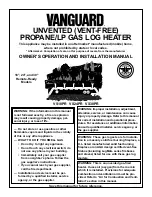
16
FOR YOUR INFORMATION
START UP CONDITIONS
DRAFT HOOD OPERATION
Check draft hood operation by performing a worst case
depressurization of the building. With all doors and windows closed,
and with all air handling equipment and exhaust fans operating such
as furnaces, clothes dryers, range hoods and bathroom fans, a match
fl ame should still be drawn into the draft hood of the water heater with
its burner fi ring. If the fl ame is not drawn toward the draft hood, shut
off water heater and make necessary air supply changes to correct.
CONDENSATE
Whenever the water heater is fi lled with cold water, some condensate
NOTE: A water temperature range of 120°F-140°F (49°C-60°C) is
recommended by most dishwasher manufacturers.
The thermostat of this water heater has been factory set at its lowest
position (PILOT LIGHTING). It is adjustable and must be reset to
the desired temperature setting to reduce the risk of scald injury.
The mark (
) indicative of approximately 120°F (49°C) is preferred
starting point. Some States have a requirement for a lower setting.
Turn the water temperature dial clockwise (
) to decrease the
temperature, or counterclockwise (
) to increase the temperature.
Should overheating occur or the gas supply fail to shut off, turn off
the manual gas control valve to the appliance.
FIGURE 15.
Temperature
Time to Produce 2nd & 3rd
Setting
Degree Burns on Adult Skin
VERY HOT = APPROX. 180°F (82°C)
Nearly instantaneous
D = APPROX. 160°F (71°C)
About 1/2 second
C = APPROX. 150°F (66°C)
About 1 1/2 seconds
B = APPROX. 140°F (60°C)
Less than 5 seconds
A = APPROX. 130°F (54°C)
About 30 seconds
= APPROX. 120°F (49°C)
More than 5 minutes
LOW = APPROX. 100°F (38°C)
- - - - - - - -
FIGURE 16.
Due to the nature of the typical gas water heater, the water
temperature in certain situations may vary up to 30F° (16.7 C°) higher
or lower at the point of use such as, bathtubs, showers, sink, etc.
HOTTER WATER CAN SCALD: Water heaters are intended to
produce hot water. Water heated to a temperature which will satisfy
space heating, clothes washing, dish washing, and other sanitizing
needs can scald and permanently injure you upon contact. Some
people are more likely to be permanently injured by hot water than
others. These include the elderly, children, the infi rm, or physically/
mentally handicapped. If anyone using hot water in your home
fi ts into one of these groups or if there is a local code or state law
requiring a certain temperature water at the hot water tap, then
you must take special precautions. In addition to using the lowest
possible temperature setting that satisfi es your hot water needs,
a means such as a mixing valve, shall be used at the hot water
taps used by these people or at the water heater. Mixing valves
are available at plumbing supply or hardware stores, see Figure
2. Follow manufacturer’s instructions for installation of the valves.
Before changing the factory setting on the thermostat, see Figures
15 and 16.
Never allow small children to use a hot water tap, or to draw their own
bath water. Never leave a child or handicapped person unattended
in a bathtub or shower.
TEMPERATURE REGULATION
will form while the burner is on. A water heater may appear to
be leaking when in fact the water is condensation. This usually
happens when:
a. A new water heater is fi lled with cold water for the fi rst time.
b. Burning gas produces water vapor in water heaters, particularly
high effi ciency models where fl ue temperatures are lower.
c. Large amounts of hot water are used in a short time and the refi ll
water in the tank is very cold.
Moisture from the products of combustion condense on the cooler
tank surfaces and form drops of water which may fall onto the burner
or other hot surfaces to produce a “sizzling” or “frying” noise.
Excessive condensation can cause pilot outage due to water running
down the fl ue tube onto the main burner and putting out the pilot.
Summary of Contents for COMMERCIAL GAS WATER HEATERS
Page 3: ...3 GENERAL SAFETY...
Page 23: ...23 NOTES...









































